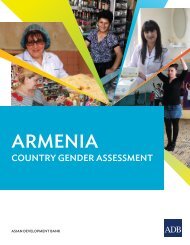Civic Activism as a Novel Component of Armenian Civil Society
English-3
English-3
You also want an ePaper? Increase the reach of your titles
YUMPU automatically turns print PDFs into web optimized ePapers that Google loves.
Table 3. NGO involvement in civic activism<br />
Level <strong>of</strong><br />
involvement<br />
Minimal involvement Moderate involvement Active involvement<br />
<strong>Civic</strong> Initiative<br />
Types <strong>of</strong><br />
Activities<br />
Dem Em; Electric<br />
Yerevan<br />
- publicise the c<strong>as</strong>e;<br />
- fact-finding<br />
Afrikyan<br />
- court litigation;<br />
- logistics;<br />
- participation in<br />
demonstrations<br />
Teghut; Maternity Leave<br />
- court litigation;<br />
- logistics;<br />
- coordination;<br />
- participation in<br />
demonstrations;<br />
- legal consulting;<br />
- fact-finding<br />
Those activists who have experience interacting with NGOs usually describe it <strong>as</strong><br />
positive and useful. As we observed, leading activists are <strong>of</strong>ten also NGO members (currently or<br />
in the p<strong>as</strong>t). Many <strong>of</strong> them mentioned NGO affiliation or work <strong>as</strong> part <strong>of</strong> the story <strong>of</strong> how they<br />
became involved in civic activism. Many activists, however, have dismissive or negative<br />
attitudes towards NGOs, <strong>as</strong> discussed below.<br />
NGO leaders and members describe their interaction with activists <strong>as</strong> positive and<br />
fruitful. NGOs have financial resources, where<strong>as</strong> activists have human resources. According to<br />
NGO members, the two groups coming together benefits the larger society. The majority <strong>of</strong><br />
NGO leaders and members interviewed recall examples <strong>of</strong> successful cooperation between the<br />
two groups, describing the cooperation <strong>as</strong> “a natural development.” NGOs see their role <strong>as</strong><br />
pr<strong>of</strong>essionals guiding and providing support to civic activists.<br />
Some NGO interviewees noted difficulties in cooperation between the two groups due to<br />
a lack <strong>of</strong> consensus and mutual understanding. They lamented a certain amount <strong>of</strong><br />
“conspiratorial thinking” regarding who does what and represents who. This (in the words <strong>of</strong> one<br />
NGO leader) h<strong>as</strong> become a social dise<strong>as</strong>e, reflecting the overall deficit <strong>of</strong> social trust.<br />
6.2. How do NGOs and Activists Perceive Each Other?<br />
While mutual perceptions are discussed in detail and from various points <strong>of</strong> view in later<br />
chapters, the main points can be highlighted here, <strong>as</strong> a summary <strong>of</strong> the c<strong>as</strong>e-b<strong>as</strong>ed discussion <strong>of</strong><br />
NGO-activist relationships. Many activists indicate the importance <strong>of</strong> distinguishing several<br />
NGOs now operating in the country from the rest. There are some strong and committed<br />
organisations, which should not be judged together with the rest <strong>of</strong> the sector.<br />
“You need to filter NGOs and understand which ones are pocket NGOs, in the<br />
government’s pocket, which ones are just donor NGOs, doing only donors’, particularly<br />
foreign government donors’ projects, and which ones are NGOs with social interests and<br />
large membership.” Female activist, 32<br />
56



